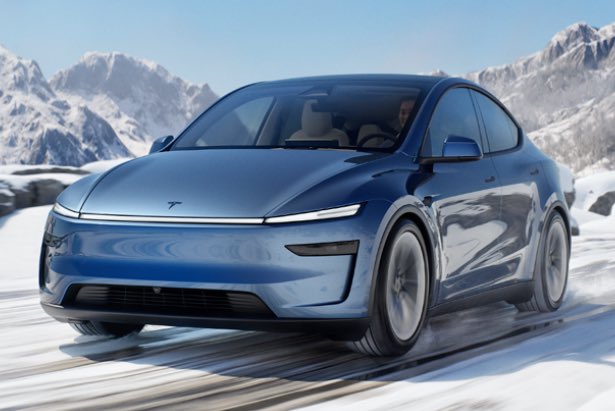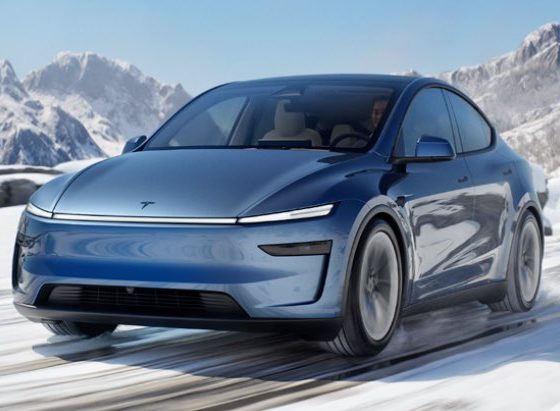Tesla has revealed some new features on the new Model Y “Juniper” through an interview conducted at one of the company’s Northern California showrooms.
Nathan Di Giusto, Tesla Vehicle Engineering Head for the 3/Y platform, and Emmanuel Lamacchia, the Model Y’s Program Manager, sat down with owners club Tesla Owners Silicon Valley to breakdown some of the new features and design changes that the company decided to make on the new Model Y.
Tesla implemented design and efficiency changes on the Model Y to make it even better than it was previously. The past iteration was the best-selling vehicle of any kind on Earth at one point, so Tesla is truly looking to improve on what many felt was an already close-to-perfect vehicle.
During the interview, Di Giusto and Lamacchia revealed some really interesting changes the company made to improve the Model Y, as well as some other things that could bleed over into other vehicles, like new paint colors and efficiency strategies.
Design Changes
- Tesla removed its ‘T’ logo from the vehicle, which was always the intention. The Chinese market required the ‘T’ logo, but the U.S. vehicle was meant to be left blank.
- The new rear power seats utilize a gearbox that was designed internally by Tesla
- Tesla chose to reintroduce the turn signal stalk because of customer feedback. When the automaker axed the stalk with past vehicles, they felt there was an overwhelming amount of drivers who would rather have it than the buttons. The buttons are still available.
- New paint colors will be heading to the North American market soon. Other markets have seen new paint colors be rolled out, but Tesla is planning to bring them to the U.S., Canada, and Mexico soon.
Efficiency Focus
- One of the biggest changes Tesla made to improve efficiency was a focus on the braking system. Tesla realized it could reduce drag from brake calipers to increase range and efficiency
- The glass roof on the new Model Y is metallically coated with two layers of silver. This not only improves cabin noise levels but also improves the cabin’s ability to maintain the heat level with better thermal performance.
- Tesla had the opportunity to implement a larger battery for more range, but it felt as if this would take the vehicle out of affordability for most consumers.
- The company examined everything from interior lighting, even in the center console, to help improve efficiency in any way possible
- HVAC fans now have a lower-speed operation
- EPA range figures will show more than the 2.8 percent estimated range bump from past Model Y
More Comfort
- Smoother and quieter closing door latches and trunk lids
- Interior materials have been wrapped to continue combatting excess cabin noise, a common issue for electric vehicles
- This includes carpeted cupholders, trunk lids, and side trim, all of which deaden the noise in the cabin and make for a quieter ride
- Vehicle sensors can now detect humans in the vehicle, along with their heartbeats and breathing patterns.
- Laminated rear glass for cabin noise reduction
Tesla’s new Model Y is set to start deliveries in March and is currently only available in the “Launch Edition” trim, which starts at $59,990 before any incentives.
The full interview with members of the Model Y program is available below.
via @teslaownersSV https://t.co/kFbP08KNVs
— TESLARATI (@Teslarati) February 6, 2025
Need accessories for your Tesla? Check out the Teslarati Marketplace:
- https://shop.teslarati.com/collections/tesla-cybertruck-accessories
- https://shop.teslarati.com/collections/tesla-model-y-accessories
- https://shop.teslarati.com/collections/tesla-model-3-accessories
Please email me with questions and comments at joey@teslarati.com. I’d love to chat! You can also reach me on Twitter @KlenderJoey, or if you have news tips, you can email us at tips@teslarati.com.

News
Tesla FSD fleet is nearing 7 billion total miles, including 2.5 billion city miles
As can be seen on Tesla’s official FSD webpage, vehicles equipped with the system have now navigated over 6.99 billion miles.

Tesla’s Full Self-Driving (Supervised) fleet is closing in on almost 7 billion total miles driven, as per data posted by the company on its official FSD webpage.
These figures hint at the massive scale of data fueling Tesla’s rapid FSD improvements, which have been quite notable as of late.
FSD mileage milestones
As can be seen on Tesla’s official FSD webpage, vehicles equipped with the system have now navigated over 6.99 billion miles. Tesla owner and avid FSD tester Whole Mars Catalog also shared a screenshot indicating that from the nearly 7 billion miles traveled by the FSD fleet, more than 2.5 billion miles were driven inside cities.
City miles are particularly valuable for complex urban scenarios like unprotected turns, pedestrian interactions, and traffic lights. This is also the difference-maker for FSD, as only complex solutions, such as Waymo’s self-driving taxis, operate similarly on inner-city streets. And even then, incidents such as the San Francisco blackouts have proven challenging for sensor-rich vehicles like Waymos.
Tesla’s data edge
Tesla has a number of advantages in the autonomous vehicle sector, one of which is the size of its fleet and the number of vehicles training FSD on real-world roads. Tesla’s nearly 7 billion FSD miles then allow the company to roll out updates that make its vehicles behave like they are being driven by experienced drivers, even if they are operating on their own.
So notable are Tesla’s improvements to FSD that NVIDIA Director of Robotics Jim Fan, after experiencing FSD v14, noted that the system is the first AI that passes what he described as a “Physical Turing Test.”
“Despite knowing exactly how robot learning works, I still find it magical watching the steering wheel turn by itself. First it feels surreal, next it becomes routine. Then, like the smartphone, taking it away actively hurts. This is how humanity gets rewired and glued to god-like technologies,” Fan wrote in a post on X.
News
Tesla starts showing how FSD will change lives in Europe
Local officials tested the system on narrow country roads and were impressed by FSD’s smooth, human-like driving, with some calling the service a game-changer for everyday life in areas that are far from urban centers.

Tesla has launched Europe’s first public shuttle service using Full Self-Driving (Supervised) in the rural Eifelkreis Bitburg-Prüm region of Germany, demonstrating how the technology can restore independence and mobility for people who struggle with limited transport options.
Local officials tested the system on narrow country roads and were impressed by FSD’s smooth, human-like driving, with some calling the service a game-changer for everyday life in areas that are far from urban centers.
Officials see real impact on rural residents
Arzfeld Mayor Johannes Kuhl and District Administrator Andreas Kruppert personally tested the Tesla shuttle service. This allowed them to see just how well FSD navigated winding lanes and rural roads confidently. Kruppert said, “Autonomous driving sounds like science fiction to many, but we simply see here that it works totally well in rural regions too.” Kuhl, for his part, also noted that FSD “feels like a very experienced driver.”
The pilot complements the area’s “Citizen Bus” program, which provides on-demand rides for elderly residents who can no longer drive themselves. Tesla Europe shared a video of a demonstration of the service, highlighting how FSD gives people their freedom back, even in places where public transport is not as prevalent.
What the Ministry for Economic Affairs and Transport says
Rhineland-Palatinate’s Minister Daniela Schmitt supported the project, praising the collaboration that made this “first of its kind in Europe” possible. As per the ministry, the rural rollout for the service shows FSD’s potential beyond major cities, and it delivers tangible benefits like grocery runs, doctor visits, and social connections for isolated residents.
“Reliable and flexible mobility is especially vital in rural areas. With the launch of a shuttle service using self-driving vehicles (FSD supervised) by Tesla in the Eifelkreis Bitburg-Prüm, an innovative pilot project is now getting underway that complements local community bus services. It is the first project of its kind in Europe.
“The result is a real gain for rural mobility: greater accessibility, more flexibility and tangible benefits for everyday life. A strong signal for innovation, cooperation and future-oriented mobility beyond urban centers,” the ministry wrote in a LinkedIn post.
News
Tesla China quietly posts Robotaxi-related job listing
Tesla China is currently seeking a Low Voltage Electrical Engineer to work on circuit board design for the company’s autonomous vehicles.

Tesla has posted a new job listing in Shanghai explicitly tied to its Robotaxi program, fueling speculation that the company is preparing to launch its dedicated autonomous ride-hailing service in China.
As noted in the listing, Tesla China is currently seeking a Low Voltage Electrical Engineer to work on circuit board design for the company’s autonomous vehicles.
Robotaxi-specific role
The listing, which was shared on social media platform X by industry watcher @tslaming, suggested that Tesla China is looking to fill the role urgently. The job listing itself specifically mentions that the person hired for the role will be working on the Low Voltage Hardware team, which would design the circuit boards that would serve as the nervous system of the Robotaxi.
Key tasks for the role, as indicated in the job listing, include collaboration with PCB layout, firmware, mechanical, program management, and validation teams, among other responsibilities. The role is based in Shanghai.
China Robotaxi launch
China represents a massive potential market for robotaxis, with its dense urban centers and supportive policies in select cities. Tesla has limited permission to roll out FSD in the country, though despite this, its vehicles have been hailed as among the best in the market when it comes to autonomous features. So far, at least, it appears that China supports Tesla’s FSD and Robotaxi rollout.
This was hinted at in November, when Tesla brought the Cybercab to the 8th China International Import Expo (CIIE) in Shanghai, marking the first time that the autonomous two-seater was brought to the Asia-Pacific region. The vehicle, despite not having a release date in China, received a significant amount of interest among the event’s attendees.










